Want to use productivity reports to measure employee performance?
Measuring productivity is essential to understand how your organization can function better.
Managers use several ways to measure employee productivity — like tracking performance metrics and implementing software or hardware systems to track employee behavior.
However, all the collected productivity data won’t make a difference if they’re not organized into a presentable form with productivity reports.
In this article, we’ll show you how to use productivity reports to measure your employees’ performance. We’ll also cover why software-based productivity reports are essential to measure productivity efficiently.
As an added bonus, we’ll reveal the best software to generate productivity reports automatically.
Table of Contents
- What is productivity?
- How to track productivity of employees
- The benefits of software-based productivity reports
- The best tool to generate automatic productivity reports
Let’s dive in.
What is productivity?
Productivity is traditionally defined as the measurement of units of output against units of input.
Generally, you can group productivity into four types:
- Labor productivity: Measures the efficiency of an organization’s employees by considering the output per labor hour.
- Capital productivity: Measures the efficiency of how the physical capital of the organization is used in manufacturing and other daily tasks.
- Material productivity: Measures the amount of input required for the production of a unit of output.
- Total factor productivity (TFP): Accounts for the overall productivity factors not included in capital, labor or material productivity.
However, service based organizations don’t necessarily use all these productivity measures. Their productivity ratios and reporting standards can vary based on the type of work the employees do.
For example, a writer’s productivity can be measured by how many articles they output in a month, while you could measure a developer’s productivity based on the aggregate number of software projects they complete within a given timeframe.
How to track productivity of employees
If you want continued productivity growth, it’s essential to know how your employees perform.
Let’s take a look at the ways you can measure the productivity of each employee:
1. Productivity metrics
A productivity metric is a specialized standard of performance measurement that differs based on the business’ functions.
Here are some metrics that can help you measure employees’ productivity levels:
A. Sales metrics
Sales metrics help managers determine the performance of their sales team.
Managers can measure if agents are productive enough or whether they need help to improve their sales workflow.
Some key sales metrics include:
- Revenue per sales agent: Total amount of revenue each agent brought in.
- Sales per rep: Total number of sales transactions an agent carried out.
B. Marketing metrics
Marketing metrics allow managers to see how well the marketing team’s efforts reflect on the revenue brought into the business.
They can then decide if more money and effort needs to go into the marketing budget.
Here are some of the top marketing metrics:
- Client acquisition cost: The total amount of marketing spend required to acquire one new client.
- Website lead conversion rate: The total number of website visitors successfully converted into leads.
C. Support metrics
The behavior of your support agents can heavily impact client retention rates.
If they aren’t courteous in a customer interaction or take too long to solve an issue, your customers will rethink doing business with you.
This is why it’s essential to keep track of support metrics. They can tell managers if workflow changes are needed to provide customers with the best level of support.
Here are some top support metrics:
- Call volume: The total number of incoming or outgoing calls from your support team.
- Customer satisfaction score: This is a rating scale that customers use to rate their satisfaction.
D. HR metrics
If you want your business to grow, you need to manage your staff well.
A key part of that is to have a successful HR team that caters to all of your business’ employee needs.
Managers can use HR metrics to understand the workflow of the HR team of the organization. The HR team should strive to lower the labor cost and find ways to improve the profitability of every employee.
Here are some comprehensive HR metrics you can use:
- Profit per employee: The total profit of the business divided among the number of employees.
- Employee turnover rate: The rate of employee exits from the business.
Want to use productivity metrics to measure the performance of remote employees?
Read our guide on how to measure remote employee productivity to find out more.
2. Productivity reports
Using productivity reports are a great way to keep track of employee productivity in your business.
A productivity report usually combines data from several metrics to give managers a broader view of employee productivity.
And unlike metrics, productivity reports aren’t limited to separate functions of the organization. You can use them to measure the productivity of your workforce across the entire organization.
But what’s the main difference between a productivity report and metric?
Metrics are just measurements that output a result with the given inputs. On the other hand, reports are comprehensive documents that provide information.
Reports can help you measure current performance against past data to see if employees are improving. You can even use this data to predict future outcomes.
There is no set format for a productivity report — you can create your own productivity reporting measures depending on the nature of your business.
For example, you could measure how long an employee spends on a single task.
Or you could use a summary report to see how long they work on several tasks of one project.
You could also make use of specialized monitoring software to see which websites and applications they’ve been using during work hours.
The benefits of software-based productivity reports

Metrics and reports are key to measuring employees’ productivity, but why are software-based productivity reports essential to measure productivity?
Let’s find out.
1. Software-based reports are more accurate
Many businesses use manual productivity reports to measure the performance of their staff.
The problem with manual reporting?
It’s not entirely accurate.
A manual productivity report is created by manually collecting data, manually processing that data and, you guessed it, manually interpreting the processed data.
Even if you use a program like Microsoft Excel to create a report in CSV format, the room for human error is massive, and anyone making the report can easily fake the data.
Using software-based reports, on the other hand, makes things a lot easier for your business.
Time tracking and employee monitoring software is accurate to the second, so you won’t have to worry about any errors. Moreover, nobody can manipulate the data since reports are created automatically.
You can easily obtain these reports and focus on productivity improvement methodologies to improve your team productivity.
2. Standard metrics can’t be used in every situation
Metrics aren’t universal — they differ based on various functions.
For example, you can’t use an HR metric to measure the performance of sales agents.
So if you want to manually measure the performance of all your employees you’ll have to employ several metrics — or you could just opt for a time tracking software instead!
Time tracking software uses the same methods to track time across your organization. This means you’ll have a common standard of measure to compare the performance of your employees relative to their workload.
With the right reporting software, you’ll be able to see how much time employees spend on tasks, which apps they use for their work and whether they’ve been idling around during work hours.
Pairing a time tracker with metrics will help you achieve a foolproof measure of tracking employee productivity.
3. Gives you better insight into employee productivity
Unlike manual methods, time tracking software individually tracks all employee data and gives you real-time access to it.
So aside from creating automatic productivity reports, you’ll also be able to track employee performance on an individual basis. You can also compare the historical data of an employee to their current performance with time tracking software.
You can use this data to understand if an employee has improved in their performance over time, or whether that employee is struggling with work.
Then, you can take action to help struggling employees improve their performance — but don’t forget to keep the other employees motivated by commending them on their performance.
The best tool to generate automatic productivity reports
We’ve covered how you can use any productivity report to track employee productivity, as well as the importance of software-generated productivity reports.
But what’s the perfect software to generate productivity reports?
If what you need is a comprehensive, easy-to-use software that automatically tracks time and produces productivity reports, then Time Doctor may just be the tool for you.
What is Time Doctor?
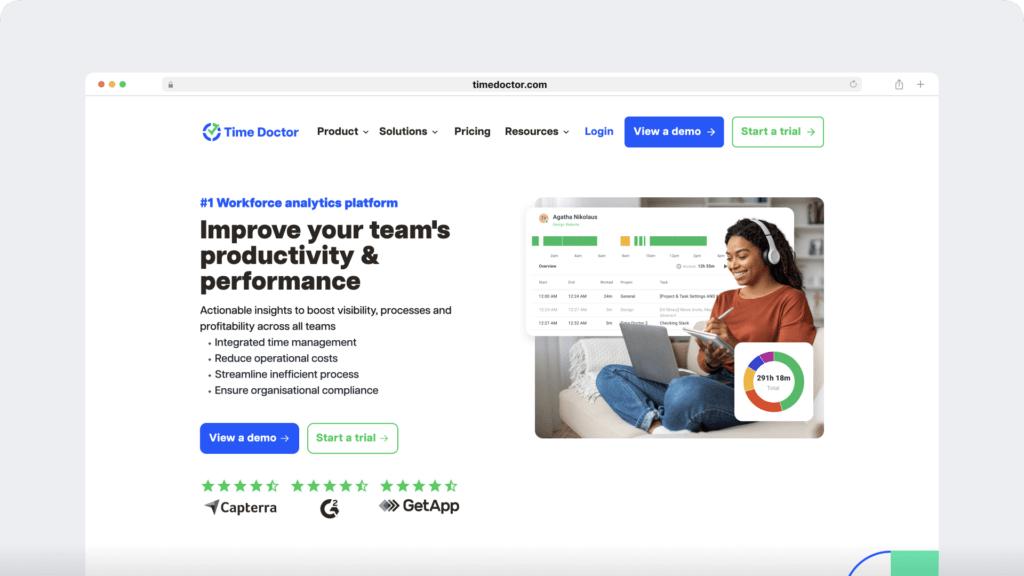
Time Doctor is a popular productivity management and time tracking tool that offers several employee-friendly settings. From large corporations to SMBs, companies and employees use Time Doctor to enhance their productivity.
You can use Time Doctor to:
- Generate productivity reports in real-time.
- Track the time any employee spends on tasks.
- Help team members from idling around at work.
- Integrate with other productivity software for maximum functionality.
Here are the features that make Time Doctor the best time tracking and productivity monitoring software:
1. Real-time productivity reports
Time Doctor has a range of productivity reports that can help you analyze staff productivity.
Let’s take a look at some of them:
A. Activity summary report
The Activity Summary report shows the amount of active minutes, seconds, unproductive hours, mobile time and manual time logged for each user within a given period.
Managers can use this report to compare the performance of employees with similar job roles.
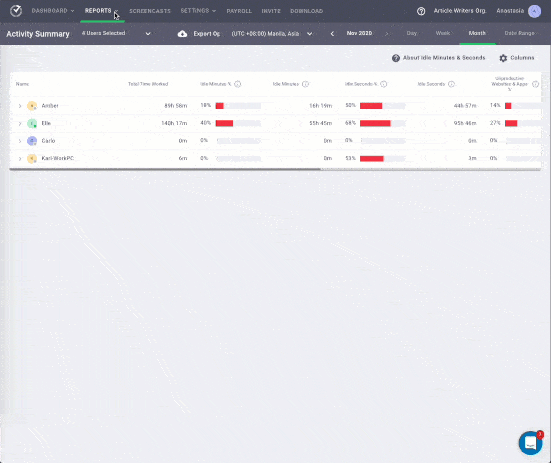
B. Hours tracked report
The Hours Tracked report shows managers how many billable hours have been logged by an employee.
You can view this report to check an employee’s monthly, weekly or daily productivity — or choose a custom date range.

C. Projects & tasks report
The Projects & Tasks report shows the amount of time spent on projects undertaken for clients. It will also show the total hours individuals spent on each task belonging to a project.
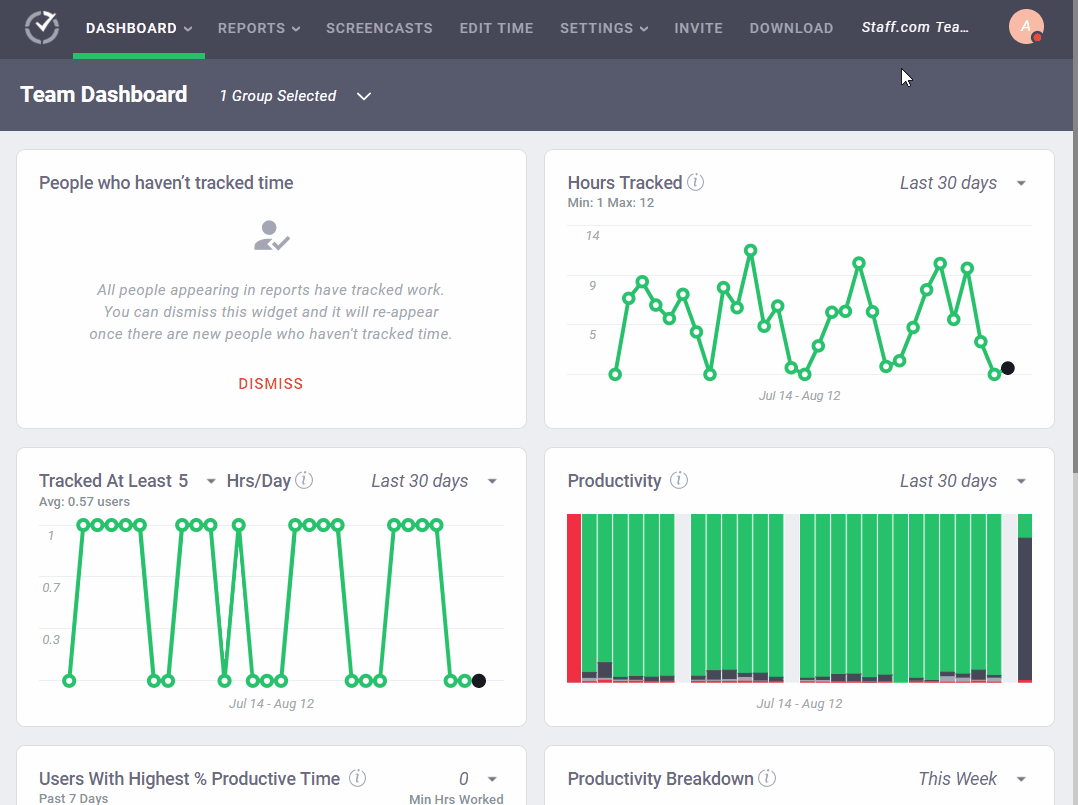
D. Timeline report
The Timeline report shows the timing of each task and break in chronological order.
You can view a daily timeline report where the tasks and break times for each day are shown – or you can view it in a weekly setting too.
The timeline report also shows the number of users online and doing a task, and who’s on break – as well as the last time a user tracked time.
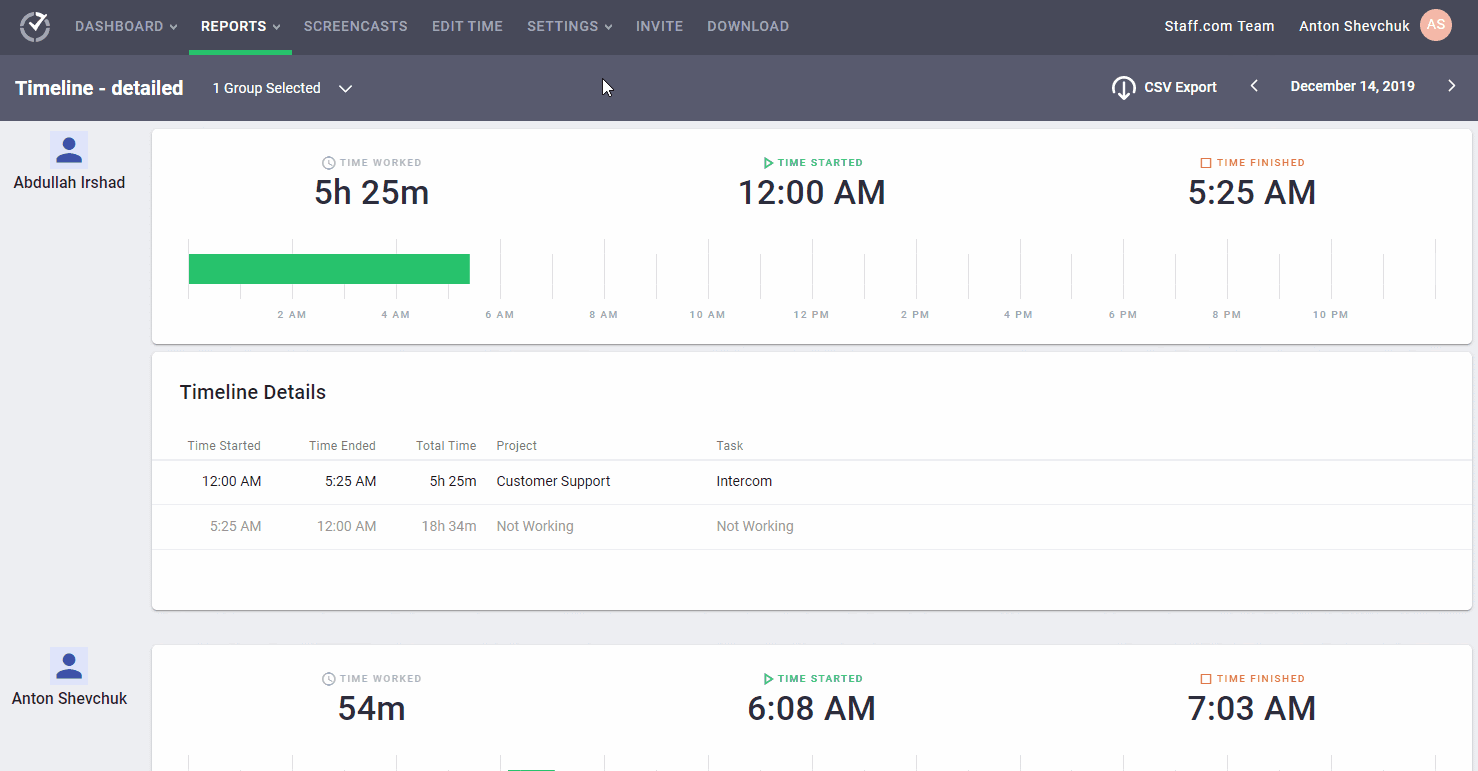
E. Web & app usage report
The Web & App Usage report shows all the sites and applications employees used during work hours.
Classify sites and applications and give them productivity ratings – so you can see how much productive and unproductive time users have clocked in while using them.
You can view the report on a daily, weekly or monthly basis as well as on a specific date range.
Time Doctor even allows you to view the report in a specific timezone for maximum flexibility.
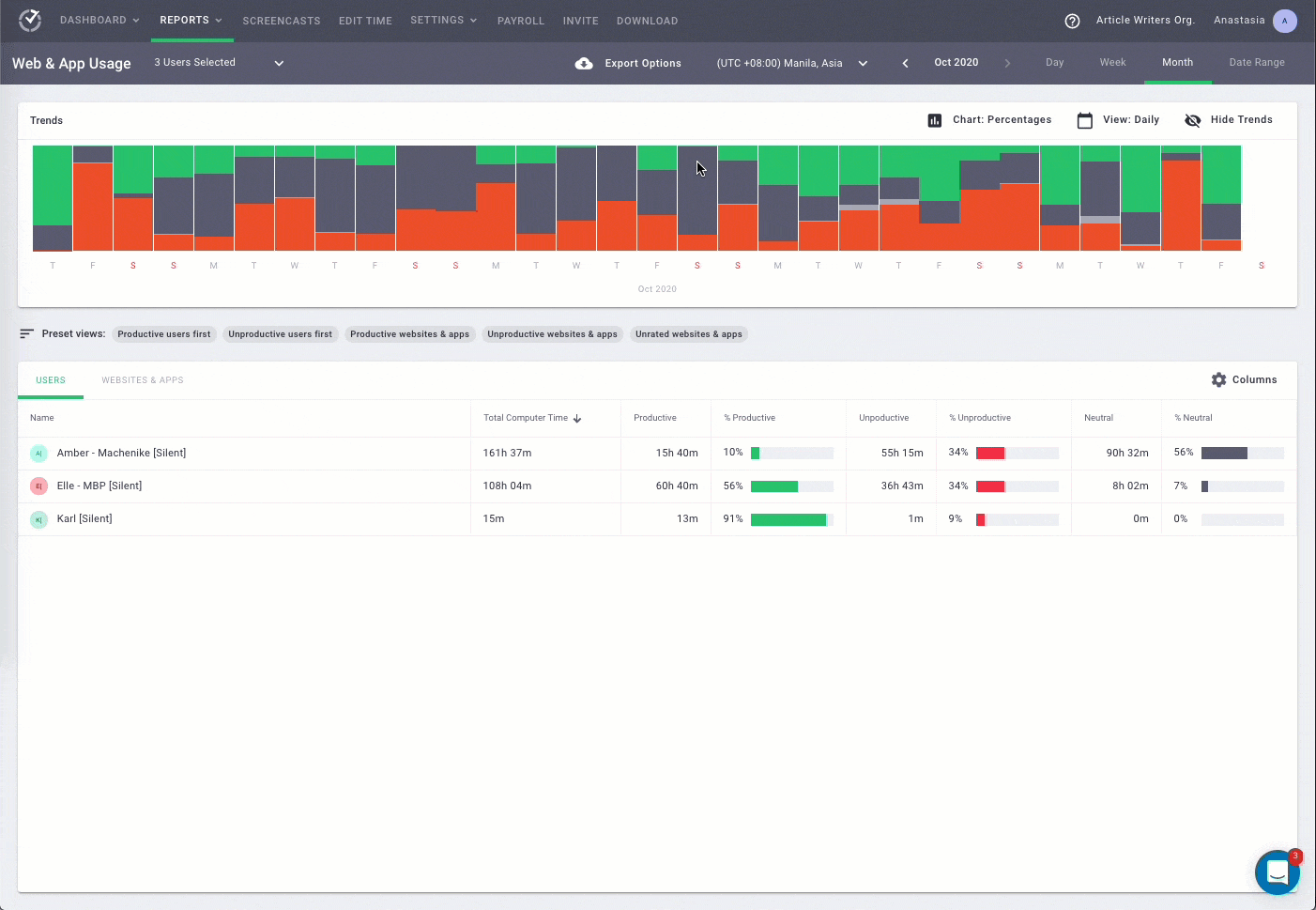
2. Simple time tracking
Time Doctor has straightforward time tracking that helps users log time without any issues.
If your business is using Time Doctor’s interactive/manual time tracking mode – all your employees have to do is open Time Doctor, type in the name of the task they’re working on and start the timer.
Time Doctor will run in the background and keep track of what the user is up to.
Once the task is done, just click on the stop button and the timer stops!

Note: Time Doctor has an automatic time tracking mode too. It tracks time automatically when the computer is turned on.
3. Minimize idle time at work
Did you know you could track the idle time of employees down to the second?
Time Doctor tracks the unproductive time of employees in idle seconds and idle minutes.
An idle second is one second without any keyboard or mouse activity, while an idle minute is one complete minute without any activity.
You can use Time Doctor’s idle time features to find out which team members are at optimal performance and which employees need help with their work. This way, employees will no longer be able to waste their work hours on social media.
Note: Time Doctor is not a keylogging software. It only tracks if any buttons/keys were pressed, it doesn’t store any mouse clicks or keystrokes.
Do you want to stop your staff from idling around at work?
Read our guide on how to avoid common time-wasters at the workplace.
4. Powerful integrations
Time Doctor allows you to integrate with a growing list of workplace and productivity tools. These integrations help teams track their productivity across several apps like Jira and ClickUp.

Wrapping up
Productivity reports are essential to boost employee productivity.
However, manual reports are prone to error and using them could lead to inaccurate decision making.
Using a time tracking tool that generates automatic productivity reports can help you easily compare and boost the productivity of every staff member.
Time Doctor is a great tool that can help you boost the productivity of your team with simple time tracking and generating automatic productivity reports. It also offers you features to prevent employees idling around and powerful integrations with other productivity tools.
So why not try out Time Doctor’s productivity reports to elevate your team’s productivity today?

Liam Martin is a serial entrepreneur, co-founder of Time Doctor, Staff.com, and the Running Remote Conference, and author of the Wall Street Journal bestseller, “Running Remote.” He advocates for remote work and helps businesses optimize their remote teams.


